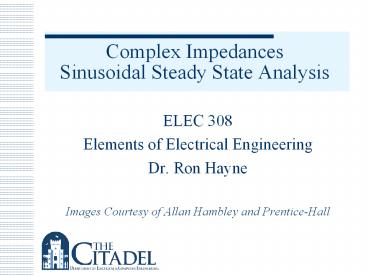Complex Impedances Sinusoidal Steady State Analysis - PowerPoint PPT Presentation
1 / 19
Title:
Complex Impedances Sinusoidal Steady State Analysis
Description:
ELEC 308 Elements of Electrical Engineering Dr. Ron Hayne Images Courtesy of Allan Hambley and Prentice-Hall * * * * * ELEC 308 ELEC 308 ELEC 308 ELEC 308 ELEC 308 ... – PowerPoint PPT presentation
Number of Views:28
Avg rating:3.0/5.0
Title: Complex Impedances Sinusoidal Steady State Analysis
1
Complex ImpedancesSinusoidal Steady State
Analysis
- ELEC 308
- Elements of Electrical Engineering
- Dr. Ron Hayne
- Images Courtesy of Allan Hambley and Prentice-Hall
2
Complex Impedances
- Inductance and Capacitance represented as Complex
Numbers
3
Inductance
4
Inductance
5
Impedance
- Ohms Law in phasor form
- Phasor voltage equals impedances times the phasor
current - Impedance is COMPLEX, in general
- Can be strictly REAL
- Impedance Resistance
- Can be strictly IMAGINARY
- Impedance Reactance
- Both inductances and capacitances
6
Capacitance
7
Capacitance
8
Resistance
- The phasors are related by
- VR RIR
9
Exercise 5.7
10
Exercise 5.8
11
Steady-State Circuit Analysis
- Circuit Analysis Using Phasors and Impedances
- Replace the time descriptions of voltage and
current sources with corresponding phasors. - All of the sources must have the SAME frequency!
- Replace inductances, capacitances, and
resistances with their corresponding impedances. - Analyze the circuit using any of the techniques
from Chapters 1 and 2 by performing the
calculations with complex arithmetic.
12
Example 5.4
- Find the steady-state current for the circuit
shown below. Also, find the phasor voltage
across each element and construct a phasor
diagram.
13
Phasor Diagram
14
Example 5.5
- Series and Parallel Combinations of Complex
Impedances - Find the voltage vc(t) in steady state. Find the
phasor current through each element, and
construct a phasor diagram showing the currents
and source voltage.
15
Phasor Diagram
16
Exercise 5.9
- Find i(t) in the circuit below. What is the
phase relationship between vs(t) and i(t)?
17
Exercise 5.9
- Find i(t) in the circuit below. What is the
phase relationship between vs(t) and i(t)?
18
Exercise 5.10
- Find the phasor voltage and current for each
circuit element.
19
Summary
- Complex Impedances
- Inductance
- Capacitance
- Resistance
- Sinusoidal Steady State Analysis
- Ohms Law
- KVL (Mesh-Current Analysis)
- KCL (Node-Voltage Analysis)































